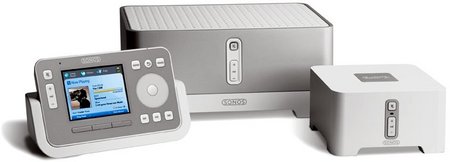Music server market set for five years of growth
Jan 15, 2008 — by Eric Brown — from the LinuxDevices Archive — 4 views ABI Research released a study predicting a shift in the digital music server market from desktop PCs to dedicated music servers. Revenue for dedicated music server hardware, including embedded-Linux products, is expected to grow to $3.2 billion by year-end 2012, says ABI.
ABI Research released a study predicting a shift in the digital music server market from desktop PCs to dedicated music servers. Revenue for dedicated music server hardware, including embedded-Linux products, is expected to grow to $3.2 billion by year-end 2012, says ABI.
digg this story |
The dedicated music server market has been hampered by high costs and difficulty of set-up, says ABI. Yet, dropping component prices, the use of standards-based off-the-shelf components and industry standards groups such as the Digital Living Network Alliance (DLNA) are helping to expand the market.
Stated research director Michael Wolf, “Many of the necessary forces are beginning to come together to enable the move of networked audio beyond the early adopter market, and networked audio servers will stand to benefit. Standards-based software and lower costs on mass storage, as well as dedicated off-the-shelf processors that enable networked media solutions are becoming a reality.”

Sonos Digital Music System
(NodePlayers and controller bundle)
(Click to enlarge)
Linux-based products have had considerable success in the early dedicated music server market, with successful systems including the Sonos Digital Music System, which is profiled in the ABI study. The following lists the key Linux-based music servers and related processors that have been announced over the last two years. Older stories on audio server products are available via links at the end of the page:
- Sonos Digital Music System (ZonePlayer) — Available at Best Buy stores since June, the Sonos music server comes in two versions: the $350 ZonePlayer 80 and the $500 ZonePlayer 100, which adds a 50-Watt Class-D amplifier. A PDA-like handheld controller costs another $400. Instead of using “home run” wiring to a massive central amplifer, resulting in lossy analog signals, the Sonos system distributes music digitally between multiple ZonePlayer nodes using Ethernet or mesh WiFi. A SonosNet protocol stack incorporates timing algorithms to ensure synchronized output on up to 32 ZonePlayers per network. This networked approach enables analog or digital musical sources to be attached to any ZonePlayer, with playback across all or parts of the network.

Pinnacle Audio Athenaeum - Pinnacle Audio Athenaeum — This ultra-high-fidelity, hard-drive-based music server is said to be capable of storing 8,800 CDs on its 3TB of storage, with lossless compression. The Athenaeum comes with a Linux-powered Nokia 770 Internet Tablet for remote control, and it features a 24-bit, 96kHz digital-to-analog converter. The device can be controlled through an AJAX-based web interface from any laptop, PC, or other browser-equipped device on the network.

Russound SMS3 - Russound SMS3 — Russound's first Linux-based media server (shown above and at the top of the page) plays music files directly from a hard drive rather than streaming them over a network. It can tune in Internet radio stations, and store photos and display them on TVs via S-video or component video. Designed for standalone or multi-zone use, the system is available in 160GB and 250GB models, both of which include connections for USB, Firewire, VGA, composite video, 10/100baseT Ethernet, RCA audio, and remote IR. There are also proprietary “RNET” ports for multi-room network control. The interface includes a “heuristic wizard” that suggests songs or playlists based on usage patterns or user moods.

Infrant Repertoire - Infrant Repertoire — Known for its low-cost networked attached storage (NAS) products, Infrant (now owned by NetGear) introduced its Repertoire music storage system in October 2006. Repertoire is not a media server, but a NAS that can store up to 3TB of media. While it lacks media playback capability, it supports seemingly every imaginable file transfer and media file streaming protocol, and enables fairly easy integration with a variety of playback and control gear. The system is powered by Infrant's IT3107 storage (SoC) system-on-chip, which integrates a 32-bit RISC CPU clocked at 280MHz, along with four ATA channels, a RAID controller, GbE MAC supporting Jumbo packets, a 64-bit SDRAM controller, and a PCI interface. The SoC was modified for the Repertoire, optimizing access to large media files.
- BridgeCo JukeBlox (Harmon Kardon and Klipsch) — BridgeCo recently announced its JukeBlox reference design for digital music systems based on a DM870 SoC (system-on-chip). This DMP processor combines a 240MHz ARM926EJ core, a dedicated security processor that supports DRM schemes, and a DSP-like audio engine core said to deliver 600 MIPS (millions of instructions per second) performance. The DM870 also integrates 64KB of SRAM, a QVGA (320×240) LCD controller, audio interfaces, and on-chip peripheral interfaces for wired and wireless Ethernet, USB 2.0, and more. The design is supported by a Linux 2.6-based middleware stack. Harmon Kardon and Klipsch have both signed on to build audio systems based on the design.
Finally, those who prefer the DIY approach may be interested in this article on how to build a Linux-based music server from scratch, or this article on LinuxMCE.
Availability
All of the above listed music servers are still being actively marketed. ABI's study, called “Networked Home Audio,” is available here
This article was originally published on LinuxDevices.com and has been donated to the open source community by QuinStreet Inc. Please visit LinuxToday.com for up-to-date news and articles about Linux and open source.